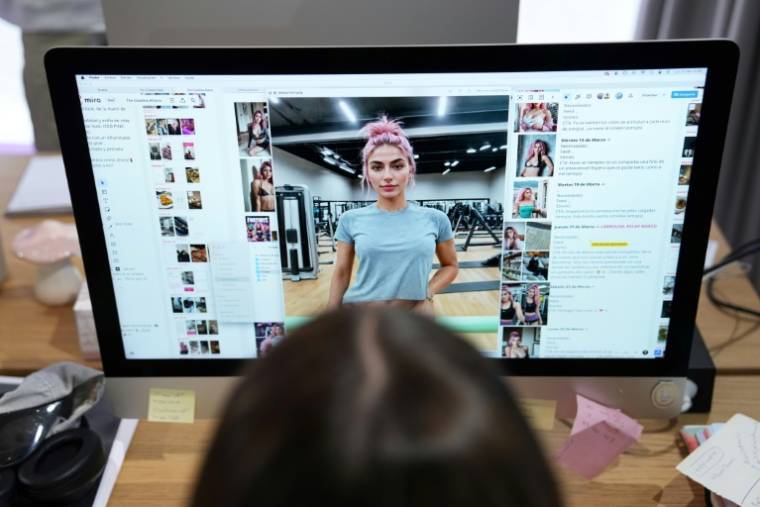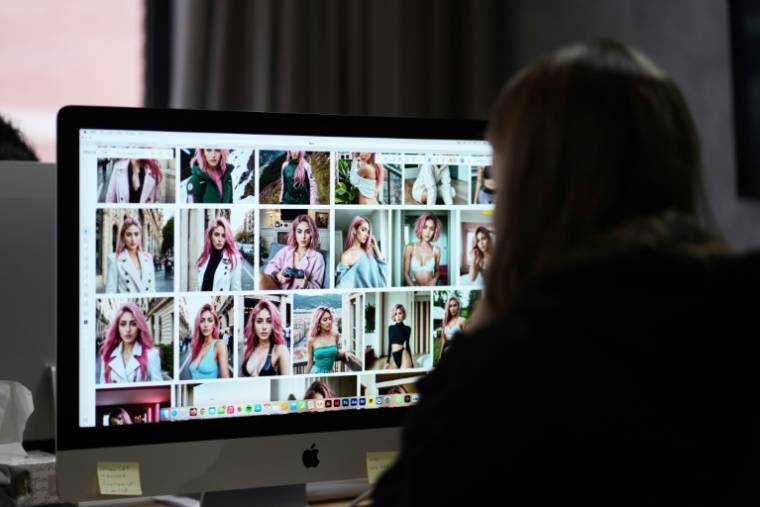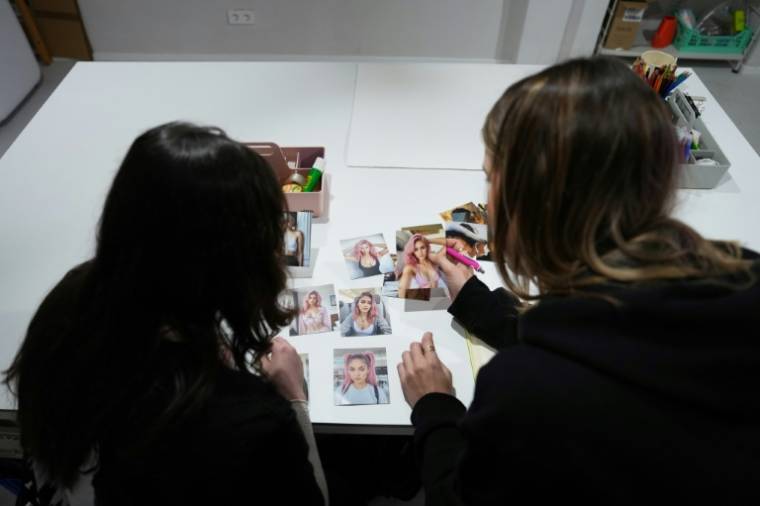Images of virtual model Aitana Lopez, generated by artificial intelligence, on March 25, 2024 in Barcelona (AFP / PAU BARRENA)
The wave of artificial intelligence which is flooding the connected world could reshuffle the cards for influencers, who intend to ride it… at the risk of being overwhelmed by this new competition?
With body-hugging outfits and pink hair, influencer Aitana is described as “strong” and “determined” by Spanish advertising agency The Clueless, which offers its services to promote various products. Except that it is not a real person who appears on the screens, but the product – very stereotypical – of the imagination of Hispanic geeks.
At a time when artificial intelligence (AI) is establishing itself in all sectors, public relations have also taken up the subject. They find undeniable economic arguments there.
“We took into account the increasing costs associated with human influencers,” underlines Sofía Novales, manager of The Clueless, from Barcelona.
Advantages? “Unparalleled creative control, enabling transparent decision-making around image, fashion and aesthetics without the need for physical photoshoots,” she argues. And “virtual models, being digital, present a more economical alternative”.
– Younger audience –
Influencers represented by avatars? Nothing really new: after all, Barbie does have an Instagram account followed by millions of followers. But they take on another dimension, even becoming actors in advertisements that look exactly like real models.

Diana Nunez, Spanish co-founder and artistic director of The Clueless agency, works on images generated by artificial intelligence of model Aitana Lopez, March 25, 2024 in Barcelona (AFP / PAU BARRENA)
This is the case for Lil Miquela, 2.6 million subscribers on Instagram. Created by a Californian agency in 2016, it has countless collaborations (read: advertisements, in the jargon of influence). Including an ad with an ultra-slick design for the German car manufacturer BMW: the objective was to “create something never seen before”, explains the company to AFP in an email. “Attracting a younger, tech-savvy generation is the icing on the cake for us.”
In France, Maud Lejeune, head of the influence and marketing agency AD Crew, analyzes: “It’s like actors on TV: we know that it doesn’t exist, yet we follow them and that interests us, it’s like watching a mini series.”
Two years ago, she created her own virtual influencer, called “Metagaya”. “The current level of design didn’t exist yet. It’s technical, you have to dress it up, take photos for the background, tell a story,” she admits with a laugh: “She wasn’t very well done!”
– “Deepfakes” –
New technological advances, such as the video generative AI Sora launched by OpenAI, could accelerate the phenomenon.
Charles Sterlings, a French influencer, sees this as an opportunity to do translations. It uses various tools, including the HeyGen and Rask.ai platforms, which enable lip syncing. In other words, the AI transforms his video, so he doesn’t need to record himself in English or Spanish.

Diana Nunez, Spanish co-founder and artistic director of The Clueless agency, works on images generated by artificial intelligence of model Aitana Lopez, March 25, 2024 in Barcelona (AFP / PAU BARRENA)
He also uses Deepshot, a dialogue generation and replacement software, to make “deepfakes”, hyperfakes, from real videos. He notably made President Emmanuel Macron speak. “I take a video of Macron and I make him say a text that is not his original text. For example, I made him talk about a government site,” he says. All in a few minutes and for a few dollars paid to the platform.
But Charles Sterlings sees the limits of the exercise: “Everyone can be an influencer from their phone. Ultimately, it will be artificial intelligence, available 24 hours a day, much cheaper to develop.”
In full growth, the influence market is whetting appetites. It could reach nearly $200 billion by 2032, according to data from Allied Market Research.
– Creators in “burn-out” –
The Clueless agency, however, denies wanting to take the place of flesh-and-blood influencers.
“We do not think that real models will become obsolete or be replaced by AI-generated models like Aitana. In our opinion, they can coexist,” says Sofia Novales.

Diana Nunez (d), Spanish co-founder and artistic director of The Clueless agency, works on printed photos generated by artificial intelligence of model Aitana Lopez, on March 25, 2024 in Barcelona (AFP / PAU BARRENA)
She compares the phenomenon to “the transition from printing shops to home printers: the new technology has not made printing shops disappear.”
For Maud Lejeune, the arrival of AI could help influencers who always have to produce more content. “It’s complicated to expose yourself in the long term: some creators experience ‘burn-outs’ (…). Perhaps virtual intelligence will be a new way of expressing yourself without exposing yourself”, she says. Especially for children.
As for the risk that malicious deepfakes will multiply, those interviewed by AFP agree. “French law adopted a law in 2023 which requires influencers to specify when they use a virtual image,” recalls lawyer Sébastien Proust, of the Herbert Smith Freehills law firm.
Already, companies are being created to authenticate images and voices. And the giant Meta has just announced on Friday its intention to identify sounds, images and videos generated by AI on its social networks, starting in May.
